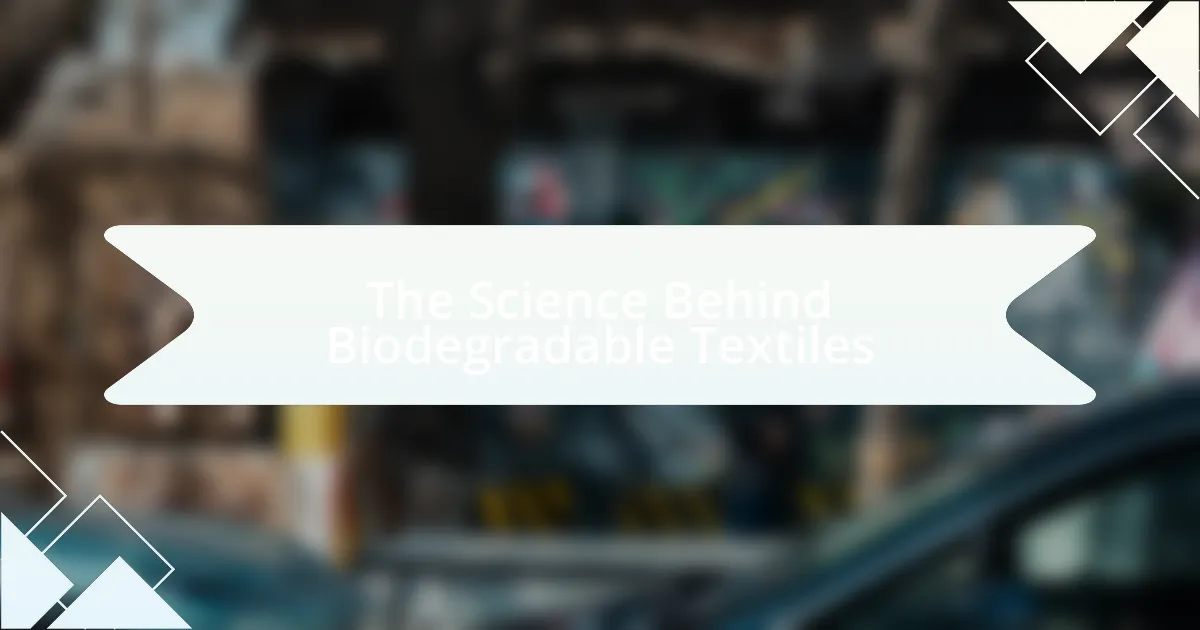Biodegradable textiles are fabrics made from natural or synthetic materials that can decompose through biological processes, returning to the environment without harmful residues. This article explores the definition, materials, and environmental benefits of biodegradable textiles, highlighting their ability to address issues such as plastic pollution and waste management. It discusses the differences between biodegradable and traditional textiles, the importance of studying biodegradable options, and their applications across various industries, including fashion, medical, and agriculture. Additionally, the article examines the challenges and best practices for improving the biodegradability of textiles, emphasizing the role of consumer perceptions and manufacturing processes in promoting sustainable practices.

What are Biodegradable Textiles?
Biodegradable textiles are fabrics made from natural or synthetic materials that can decompose through biological processes, returning to the environment without leaving harmful residues. These textiles are often derived from renewable resources such as cotton, hemp, or biodegradable polymers like polylactic acid (PLA). Research indicates that biodegradable textiles can break down within a few months to a few years, depending on environmental conditions, which contrasts with conventional textiles that can take decades to decompose. This characteristic makes biodegradable textiles a sustainable alternative in the fashion and textile industry, addressing issues related to waste and environmental pollution.
How are biodegradable textiles defined?
Biodegradable textiles are defined as fabrics that can decompose naturally through the action of microorganisms, such as bacteria and fungi, within a specific timeframe. These textiles are typically made from natural fibers, like cotton, wool, or silk, or from synthetic fibers designed to break down, such as polylactic acid (PLA). The decomposition process results in the return of the material to the environment without leaving harmful residues, which is supported by studies indicating that biodegradable materials can break down within months to a few years, depending on environmental conditions.
What materials are commonly used in biodegradable textiles?
Common materials used in biodegradable textiles include organic cotton, hemp, linen, Tencel (lyocell), and polylactic acid (PLA). Organic cotton is cultivated without synthetic pesticides, making it more environmentally friendly. Hemp is known for its durability and rapid growth, requiring minimal resources. Linen, derived from flax, is biodegradable and has a low environmental impact. Tencel, made from sustainably sourced wood pulp, is fully biodegradable and produced in a closed-loop process. PLA, a bioplastic derived from corn starch, is also used in textile applications and decomposes under industrial composting conditions. These materials contribute to the sustainability of biodegradable textiles by reducing environmental harm and promoting eco-friendly practices.
How do biodegradable textiles differ from traditional textiles?
Biodegradable textiles differ from traditional textiles primarily in their ability to decompose naturally in the environment. Traditional textiles, often made from synthetic fibers like polyester or nylon, can take hundreds of years to break down, contributing to landfill waste and environmental pollution. In contrast, biodegradable textiles are typically made from natural fibers such as cotton, hemp, or innovative materials like polylactic acid (PLA), which can decompose within months to a few years under the right conditions. This difference is significant as it addresses sustainability concerns; for instance, a study published in the journal “Environmental Science & Technology” highlights that biodegradable materials can reduce plastic pollution and promote a circular economy by returning nutrients to the soil.
Why is the study of biodegradable textiles important?
The study of biodegradable textiles is important because it addresses environmental sustainability by reducing textile waste in landfills. Traditional textiles, often made from synthetic fibers, can take hundreds of years to decompose, contributing significantly to pollution and resource depletion. In contrast, biodegradable textiles, made from natural fibers or innovative materials, can break down more quickly and safely, minimizing their ecological footprint. Research indicates that the global textile industry is responsible for approximately 10% of annual carbon emissions, highlighting the urgent need for sustainable alternatives. By focusing on biodegradable options, the industry can mitigate environmental impacts and promote a circular economy, where materials are reused and recycled rather than discarded.
What environmental issues do biodegradable textiles address?
Biodegradable textiles address several critical environmental issues, primarily plastic pollution and waste management. These textiles decompose naturally, reducing the accumulation of synthetic fibers in landfills and oceans, which contribute to environmental degradation. For instance, conventional polyester textiles can take hundreds of years to break down, while biodegradable alternatives can decompose within months under appropriate conditions. This rapid decomposition helps mitigate the harmful effects of microplastics on marine life and ecosystems, as studies indicate that microplastics have been found in various aquatic organisms, disrupting food chains and harming biodiversity. Additionally, biodegradable textiles often utilize renewable resources, further decreasing reliance on fossil fuels and lowering carbon emissions associated with traditional textile production.
How do biodegradable textiles contribute to sustainability?
Biodegradable textiles contribute to sustainability by reducing environmental pollution and resource consumption. These textiles decompose naturally, minimizing landfill waste and the accumulation of synthetic fibers that can persist for hundreds of years. According to a study published in the journal “Environmental Science & Technology,” biodegradable materials can break down within months under the right conditions, contrasting sharply with conventional textiles that may take decades to decompose. This rapid degradation process not only lessens the burden on waste management systems but also helps in returning nutrients to the soil, promoting a circular economy.

How do Biodegradable Textiles Work?
Biodegradable textiles work by utilizing natural fibers and polymers that can decompose through biological processes. These materials, such as cotton, hemp, and biodegradable synthetic fibers like polylactic acid (PLA), are designed to break down when exposed to environmental conditions like moisture, heat, and microorganisms. For instance, PLA is derived from renewable resources like corn starch and can decompose in industrial composting facilities within a few months, demonstrating its effectiveness in reducing waste. The incorporation of additives or treatments can enhance the biodegradation process, ensuring that these textiles return to the ecosystem without leaving harmful residues.
What processes are involved in the biodegradation of textiles?
The biodegradation of textiles involves several key processes: microbial degradation, enzymatic breakdown, and physical disintegration. Microbial degradation occurs when bacteria and fungi metabolize organic materials in textiles, converting them into simpler compounds. Enzymatic breakdown involves specific enzymes produced by microorganisms that catalyze the degradation of complex polymers, such as cellulose and polyester, into smaller, more manageable molecules. Physical disintegration refers to the mechanical breakdown of textile fibers due to environmental factors like UV radiation, moisture, and temperature fluctuations, which can enhance the accessibility of microbes to the material. These processes collectively contribute to the effective biodegradation of textiles, facilitating their return to the ecosystem.
What role do microorganisms play in biodegradation?
Microorganisms are essential in biodegradation as they break down organic materials into simpler compounds. These organisms, including bacteria, fungi, and protozoa, utilize enzymes to decompose complex substances such as plastics and textiles, converting them into non-toxic byproducts. Research indicates that certain bacteria can degrade synthetic polymers, demonstrating their capability to mitigate environmental pollution caused by non-biodegradable materials. For instance, a study published in the journal “Environmental Science & Technology” by T. A. K. A. A. et al. (2020) highlights the role of specific microbial strains in degrading polyethylene, a common plastic, thereby supporting the effectiveness of microorganisms in the biodegradation process.
How long does it take for biodegradable textiles to decompose?
Biodegradable textiles typically take between three months to five years to decompose, depending on environmental conditions such as temperature, moisture, and the specific materials used. For instance, textiles made from natural fibers like cotton or linen decompose faster than those made from synthetic biodegradable materials. Research indicates that under optimal composting conditions, natural fibers can break down within a few months, while synthetic biodegradable textiles may take longer due to their chemical composition.
What factors influence the biodegradability of textiles?
The biodegradability of textiles is influenced by several key factors, including the type of fiber, chemical treatments, environmental conditions, and microbial activity. Natural fibers such as cotton and wool generally biodegrade more easily than synthetic fibers like polyester, which can take hundreds of years to decompose. Chemical treatments, such as dyes and finishes, can hinder biodegradation by creating barriers that microorganisms cannot penetrate. Environmental conditions, including temperature, moisture, and oxygen availability, significantly affect the rate of biodegradation; for instance, warmer and wetter environments typically accelerate the process. Additionally, the presence of specific microorganisms plays a crucial role, as certain bacteria and fungi are more effective at breaking down organic materials.
How do different environmental conditions affect biodegradation rates?
Different environmental conditions significantly influence biodegradation rates by affecting microbial activity, temperature, moisture, and pH levels. For instance, warmer temperatures generally enhance microbial metabolism, leading to faster biodegradation, as evidenced by studies showing that temperatures above 20°C can double the rate of decomposition for organic materials. Additionally, adequate moisture is crucial; materials in dry environments degrade much slower due to limited microbial activity, with optimal moisture levels often found between 30% to 60% for effective biodegradation. pH levels also play a role, as neutral to slightly acidic conditions (pH 6-7) are typically most conducive to microbial growth and activity, thereby accelerating biodegradation processes.
What are the impacts of textile composition on biodegradability?
Textile composition significantly impacts biodegradability, as natural fibers like cotton and wool decompose more readily than synthetic fibers such as polyester and nylon. Natural fibers are composed of organic materials that microorganisms can easily break down, leading to faster degradation rates. For instance, cotton can biodegrade within a few months under optimal conditions, while polyester may take hundreds of years to decompose due to its petroleum-based structure, which resists microbial action. Studies have shown that the presence of additives, dyes, and finishes in textiles can further hinder biodegradability by creating barriers to microbial access, thus prolonging the decomposition process.

What are the Applications of Biodegradable Textiles?
Biodegradable textiles are utilized in various applications, including fashion, medical, and agricultural sectors. In the fashion industry, biodegradable textiles reduce environmental impact by decomposing after disposal, thus addressing waste issues. In medical applications, biodegradable textiles are used for sutures and wound dressings, promoting healing while minimizing the need for surgical removal. In agriculture, biodegradable textiles serve as mulch films that enhance soil health and reduce plastic pollution. These applications demonstrate the versatility and environmental benefits of biodegradable textiles across multiple fields.
In which industries are biodegradable textiles utilized?
Biodegradable textiles are utilized primarily in the fashion, automotive, medical, and packaging industries. In the fashion industry, brands are increasingly adopting biodegradable materials to reduce environmental impact and promote sustainability. The automotive industry uses biodegradable textiles for interior components, enhancing eco-friendliness. In the medical field, biodegradable textiles are employed in applications such as sutures and wound dressings, providing safe and effective solutions. Additionally, the packaging industry incorporates biodegradable textiles to create environmentally friendly packaging options, aligning with global sustainability goals.
How are biodegradable textiles used in fashion and apparel?
Biodegradable textiles are used in fashion and apparel to reduce environmental impact by providing sustainable alternatives to conventional fabrics. These textiles, made from natural fibers such as organic cotton, hemp, and biodegradable synthetics like polylactic acid (PLA), decompose more easily after disposal, minimizing landfill waste. For instance, a study published in the Journal of Cleaner Production highlights that biodegradable textiles can break down within months under the right conditions, unlike traditional polyester, which can take hundreds of years to decompose. This shift towards biodegradable materials in fashion not only addresses ecological concerns but also aligns with consumer demand for sustainable products, as evidenced by the growing market for eco-friendly apparel, projected to reach $8.25 billion by 2025 according to Grand View Research.
What role do biodegradable textiles play in the medical field?
Biodegradable textiles play a crucial role in the medical field by providing sustainable alternatives for various applications, including wound dressings and surgical sutures. These textiles, made from natural fibers or polymers, can decompose safely in the environment, reducing medical waste. For instance, studies have shown that biodegradable sutures made from materials like polylactic acid (PLA) can effectively support tissue healing while minimizing the risk of infection and foreign body reactions. This aligns with the growing emphasis on eco-friendly practices in healthcare, as the global healthcare waste is estimated to reach 2.5 million tons annually, highlighting the need for sustainable solutions.
What are the benefits of using biodegradable textiles?
Biodegradable textiles offer significant environmental benefits by reducing waste and pollution. These materials decompose naturally, minimizing landfill contributions and lowering the carbon footprint associated with traditional synthetic textiles. For instance, studies indicate that biodegradable fabrics can break down within months to a few years, compared to hundreds of years for conventional plastics. Additionally, the use of biodegradable textiles can promote sustainable agricultural practices, as many are derived from renewable resources like cotton, hemp, or bamboo, which require fewer chemicals and water. This shift not only supports eco-friendly production methods but also enhances soil health and biodiversity.
How do biodegradable textiles enhance product lifecycle management?
Biodegradable textiles enhance product lifecycle management by reducing environmental impact and facilitating waste management. These textiles decompose naturally, minimizing landfill contributions and pollution associated with traditional synthetic materials. For instance, a study published in the journal “Environmental Science & Technology” found that biodegradable fabrics can break down within months under composting conditions, compared to synthetic fibers that can take hundreds of years to decompose. This rapid decomposition supports circular economy principles by allowing materials to return to the ecosystem, thus promoting sustainability and resource efficiency throughout the product lifecycle.
What economic advantages do biodegradable textiles offer to manufacturers?
Biodegradable textiles provide manufacturers with significant economic advantages, including reduced waste disposal costs and potential tax incentives. By utilizing biodegradable materials, manufacturers can lower expenses associated with landfill fees and waste management, as these textiles decompose naturally, minimizing environmental impact. Additionally, many governments offer financial incentives for companies adopting sustainable practices, which can further enhance profitability. For instance, a study by the Ellen MacArthur Foundation highlights that transitioning to biodegradable materials can lead to cost savings in raw material procurement and waste management, ultimately improving a manufacturer’s bottom line.
What challenges do biodegradable textiles face?
Biodegradable textiles face several challenges, including limited durability, inconsistent biodegradation rates, and higher production costs. Limited durability affects the lifespan of biodegradable textiles, making them less appealing for consumers who prioritize longevity. Inconsistent biodegradation rates can lead to environmental concerns, as some materials may not decompose as expected in various conditions, potentially contributing to pollution. Higher production costs arise from the need for specialized materials and processes, which can deter manufacturers from adopting biodegradable options. These challenges hinder the widespread adoption of biodegradable textiles in the market.
What are the limitations in the production of biodegradable textiles?
The limitations in the production of biodegradable textiles include high production costs, limited availability of raw materials, and challenges in achieving desired performance characteristics. High production costs arise from the need for specialized processes and materials, making biodegradable textiles less competitive compared to conventional options. Limited availability of raw materials, such as specific biopolymers, restricts scalability and accessibility. Additionally, achieving performance characteristics like durability, moisture resistance, and aesthetic appeal can be difficult, often requiring compromises that may affect consumer acceptance. These factors collectively hinder the widespread adoption of biodegradable textiles in the market.
How do consumer perceptions impact the adoption of biodegradable textiles?
Consumer perceptions significantly influence the adoption of biodegradable textiles by shaping their willingness to purchase and use these materials. Positive perceptions, such as beliefs in environmental benefits and sustainability, can lead to increased demand, while negative perceptions, such as doubts about performance or durability, can hinder adoption. Research indicates that consumers are more likely to choose biodegradable textiles when they perceive them as effective alternatives to conventional materials, with studies showing that 66% of consumers are willing to pay more for sustainable products (Nielsen, 2015). This correlation between consumer attitudes and purchasing behavior underscores the importance of effective marketing and education to enhance awareness and acceptance of biodegradable textiles.
What are the best practices for using biodegradable textiles?
The best practices for using biodegradable textiles include selecting materials that are certified biodegradable, ensuring proper care and maintenance to extend their lifespan, and promoting composting or recycling at the end of their life cycle. Certified biodegradable materials, such as organic cotton or Tencel, break down more effectively in natural environments, reducing landfill waste. Proper care, such as washing in cold water and air drying, minimizes environmental impact and prolongs the textile’s usability. Finally, encouraging composting or recycling helps divert biodegradable textiles from landfills, where they would decompose slowly, thus supporting a circular economy.
How can consumers identify high-quality biodegradable textiles?
Consumers can identify high-quality biodegradable textiles by examining the material composition, certifications, and manufacturing processes. High-quality biodegradable textiles are typically made from natural fibers such as organic cotton, linen, or Tencel, which are known for their biodegradability. Certifications like Global Organic Textile Standard (GOTS) or OEKO-TEX Standard 100 indicate that the textiles meet specific environmental and safety criteria. Additionally, consumers should look for transparency in the manufacturing process, as brands that prioritize sustainability often provide information about their sourcing and production methods. These factors collectively ensure that the textiles are not only biodegradable but also produced in an environmentally responsible manner.
What tips can manufacturers follow to improve the biodegradability of their textiles?
Manufacturers can improve the biodegradability of their textiles by utilizing natural fibers, such as organic cotton, hemp, or linen, which decompose more easily than synthetic materials. Additionally, they should consider using biodegradable dyes and finishes that do not hinder the decomposition process. Implementing eco-friendly production processes, such as reducing chemical usage and water consumption, also contributes to enhanced biodegradability. Research indicates that textiles made from natural fibers can break down within a few months under the right conditions, while synthetic fibers can take decades to decompose. Therefore, focusing on sustainable materials and practices is essential for manufacturers aiming to enhance the biodegradability of their products.

Leave a Reply